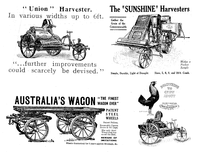


Chapter 1
I Groping In A Strange Environment: 1788-1851
II Farmers Take The Initiative: 1851-1888
i Setting the scene for change
ii A transplanted community; a transplanted technology
iii The development of appropriate technology
iv Importation, adaptation and innovation in cropping
v Introduction and innovation in livestock husbandry
III Enter Education And Science: 1888-1927
IV Agricultural Science Pays Dividends: 1927-1987
V Examples Of Research And Development 1928-1988
VI International Aspects Of Agricultural Research
VII Future Prospects
VIII Acknowledgements
References
Index
Search
Help
Contact us

Importation, adaptation and innovation in cropping
The development of the local agricultural engineering industry from the 1860s to the depression in the early 1890s, together with the rapid progress in agricultural machinery manufacture in the United Kingdom and United States, helped Australian agriculture towards the development of low cost, low labour, extensive systems of production. The major agricultural machinery and implement makers in the United Kingdom and the United States advertised extensively in the Australian press and demonstrated their products at local agricultural shows. These overseas engineering industries were more highly developed than those in Australia and so the more complex machines such as steam engines, and reapers and binders, tended to be imported; whereas local makers of ploughs and simpler items were able to challenge the importers of such products, especially as the local ploughs were adapted to be used for the shallower ploughing and the breaking up of the turned furrow which had been found more appropriate to the soils and baking temperatures of Australia.Some problems were peculiar to Australia and it was these in particular that the local machinery makers and farmers set out to solve. Cropping difficulties arose as wheat growing was expanded into the dry Mallee country of South Australia and Victoria. The vegetation of this country consisted of a dense cover of Mallee eucalyptus (a small tree which characteristically has several stems growing from large stumps at or just below ground level) which had to be grubbed out before the land could be cultivated. This was a slow and costly process until a scrub roller was devised which could be pulled through the scrub by horses or bullocks, flattening the small trees and undergrowth as it went. The flattened vegetation was then left to dry before it was burnt. This invention has been attributed by various writers to a settler called Mullens, but Charles Branson also claimed to be the inventor.

The scrub (or mallee) roller still left stumps in the ground which made ploughing difficult, until the stump-jump plough was brought into use. In 1876 a local agricultural implement maker, Richard Bowyer Smith, exhibited his 'Vixen' three-furrow stump-jump plough. When one of the mouldboards on this plough hit a stump or root, its levers allowed it to rise out of the ground and pass over the obstruction, thus enabling partially cleared land to be cultivated successfully. The stump-jump mechanism was not a totally new idea, but Smith developed it into a practical implement which was widely accepted and copied after some initial opposition. In cases such as the mallee roller, the earlier development of the stripper and similar inventions, it is perhaps invidious to name only one person as the inventor, when several people were working on similar ideas at the same time in the same locality, all encouraged by the prospect of government and agricultural society awards if they were successful. The developments of the mallee roller and the stump-jump plough together so transformed the economics of clearing, cultivating and cropping Mallee country that between 1878 and 1881 more than half a million acres of new land was taken up by wheat farmers.[27]
People in Bright Sparcs - Smith, Richard Bowyer
 |
Australian Academy of Technological Sciences and Engineering |  |
© 1988 Print Edition pages 11 - 12, Online Edition 2000
Published by Australian Science and Technology Heritage Centre, using the Web Academic Resource Publisher
http://www.austehc.unimelb.edu.au/tia/015.html